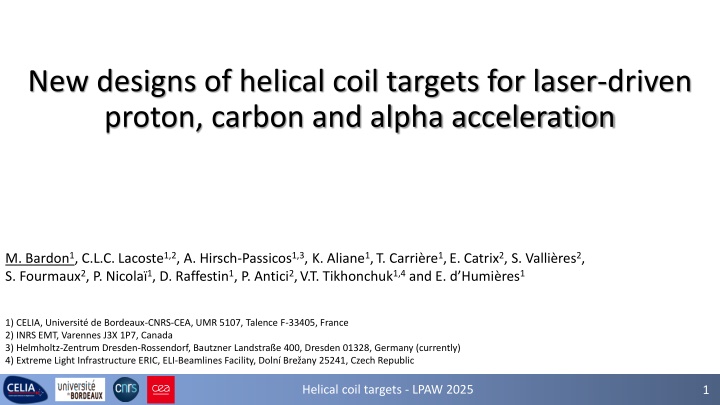
Helical Coil Targets for Laser-driven Proton and Ion Acceleration
Explore new helical coil targets designed for laser-driven proton, carbon, and alpha acceleration, featuring motivations, target specifications, experimental results, and current dispersion analysis in the context of advanced ion acceleration techniques.
Download Presentation

Please find below an Image/Link to download the presentation.
The content on the website is provided AS IS for your information and personal use only. It may not be sold, licensed, or shared on other websites without obtaining consent from the author. If you encounter any issues during the download, it is possible that the publisher has removed the file from their server.
You are allowed to download the files provided on this website for personal or commercial use, subject to the condition that they are used lawfully. All files are the property of their respective owners.
The content on the website is provided AS IS for your information and personal use only. It may not be sold, licensed, or shared on other websites without obtaining consent from the author.
E N D
Presentation Transcript
New designs of helical coil targets for laser-driven proton, carbon and alpha acceleration M. Bardon1, C.L.C. Lacoste1,2, A. Hirsch-Passicos1,3, K. Aliane1,T. Carri re1,E. Catrix2, S. Valli res2, S. Fourmaux2, P. Nicola 1, D. Raffestin1, P. Antici2,V.T. Tikhonchuk1,4and E. d Humi res1 1) CELIA, Universit de Bordeaux-CNRS-CEA, UMR 5107, Talence F-33405, France 2) INRS EMT, Varennes J3X 1P7, Canada 3) Helmholtz-Zentrum Dresden-Rossendorf, Bautzner Landstra e 400, Dresden 01328, Germany (currently) 4) Extreme Light Infrastructure ERIC, ELI-Beamlines Facility, Doln Bre any 25241, Czech Republic Helical coil targets - LPAW 2025 1
Motivations Development of a new tunable proton source for different applications TNSA beam features Most robust laser-driven ion acceleration process: the TNSA TNSA proton energy distribution TNSA proton half-angular divergence 20 M. Roth et al, CERN Yellow Reports (2016) D. Raffestin et al. Matter Radiat. Extremes 6, 056901 (2021) TNSA beam features are not suitable for various applications We need to shape this proton beam ICF fast ignition scheme Radioisotope production Proton isochoric heating p+ PET scan p+ WDM studies Sc isotopes laser laser Proton target Heated target Proton target Calcium target Helical coil targets - LPAW 2025 2
Helical coil target (HC) Discharge current pulse Length L (5-20mm) ?? Target Radius a (0.4-1mm) Protons Laser Helix ?? ? is not strong enough to act on protons S. Kar et al., Nature Com. 7 10792 (2016) Pitch h (0.3-0.8mm) Proton beam is focused, collimated, post-accelerated & bunched by the helical-coil Only one single laser beam is needed to generate the protons and the discharge current Helix acts as a EM wave-guide & also as a delay line Rules to design a helical-coil 2+ 4?2?2 ? = Proton and current pulse propagations must be synchronized PIC simulation (Sophie) ??????? Protons ? ? ?????? Current Current pulse must spread over, at least, one turn 2? Helical coil targets - LPAW 2025 3
Results of the Pacman 1 experiment on LULI2000 (2019) M. Bardon et al., PPCF 62, 125019 (2020) RCF without HC 50J, 1ps Focusing RCF with HC Fluence multiplied by 10 (E>12MeV) 30% increase in the cut-off energy Limited bunching Limited yield (~10%) Helical coil targets - LPAW 2025 4
Results of the Pacman 2 experiment on LULI2000 (2020) Variations on the helical coil length Cut-off energy does not increase with the coil length Post-acceleration is not efficient all along the coil length Why? Helical coil targets - LPAW 2025 5
Current dispersion M. Bardon et al., PPCF 62 125019 (2020) HC parameters: a=0.5mm h=0.35mm Current pulse propagation along the helical coil is dispersed Acceleration Current pulse (~10ps) has a broadband frequency spectrum Frequencies do not propagate at the same speed This will modulate the current pulse intensity Deceleration ??? Bunching Acceleration ? PIC simulation (Sophie) ???= 1 + 2??/ 2 Splitting Deceleration A series of small bunches is produced. Bunching & acceleration are not efficient all along the HC Helical coil targets - LPAW 2025 6
New helical coil design with a tube (HCT) Tube limits the current dispersion along the helix Target Tube Holder Helix LASER Holder With tube Without tube and increases the proton bunching HC without tube TNSA A. Hirsch-Passicos et al., Phys. Rev. E 109, 025211 (2024) HC with tube We are able to predict the energy of the bunches depending on the HCT geometry E [MeV] Helical coil targets - LPAW 2025 7
Experiment at the ALLS facility (INRS-EMT Canada - June 2024) First time that a Thomson Parabola was used as main diagnostic in a HC experiment ALLS parameters Elaser= t = Spot size (FWHM) = 5 m I = Target : 3J (on target) 30fs 1020 W/cm2 Ta (2 m) Helical coil targets - LPAW 2025 8
ALLS experiment: Results on the proton spectrum RCF We had some issues with: The target assembly with tubes, The current intensity in the coil was weaker than expected. But, with the helical coil, we observed: A good focusing & collimation of the proton beam (2 divergence), An increase in the proton temperature, An increase in the proton cut-off energy. We successfully identified the appropriate input parameters for our simulations to achieve a good agreement with the measurement on the proton spectrum. C.L.C. Lacoste et al., Matter Radiat. Extremes 10, 037602 (2025) Helical coil targets - LPAW 2025 9
ALLS experiment: Results on the carbon spectrum Results also confirmed by PIC simulations 3 MCP images of the TPS Same inputs parameter as the ones we used to reproduce the proton spectrum protons carbons Same inputs for both simulations HC geometry can be optimized for carbons Carbons are suppressed by the HC in this geometry Proton beam at the HC exit is quite pure First experimental evidence that the HC can act on carbons C.L.C. Lacoste et al., Matter Radiat. Extremes 10, 037602 (2025) Helical coil targets - LPAW 2025 10
Bunching of alpha particles with HCT for radioisotopes production Nuclear cross-section reaction of a Ca target PIC simulations (Sophie) Alpha particles bunching with HCT Based on simulated alpha spectra for LFEX laser (ILE-Japan) 3 HCT geometries C.L.C Lacoste et al., Submitted to Phys. Rev. & Part. Beams (2025) We can strongly increase the Sc44 production (confirmed by Fluka simulations) need to be validated by an experiment Helical coil targets - LPAW 2025 11
Conclusion New designs of HC with tube (HCT) were developped to mitigate current dispersion & increase proton bunching Need to improve the target assembly with tube ALLS experiment is the first evidence that HC can act, not only on protons, but also on carbons PIC simulations show that HCT can also bunch, focus & accelerate alpha particles for radioisotopes production Next steps Experimental validation of HCT at high energy & high intensity with the LFEX laser (ILE-Japan) Towards high repetition rate: firts step is to dissociate the proton generation from the current pulse production This will be performed with the use of 2 laser beams at DRACO facility (HZDR-Germany) Helical coil targets - LPAW 2025 12
Acknowledgements CELIA C. Lacoste, K. Aliane, T. Carri re, H. Larreur, M. Ben Tayeb, M. Huault, T. Guilberteau, M. Lafargue, J. Lopez, L. Merzeau, F. Blais, R. Bouillaud, N. Fedorov, I. Manek-H nninger, J.L. Feugeas, D. Batani, P. Nicola , D. Raffestin, V.T. Tikhonchuk and E. d Humi res INRS E. Catrix, S. Valli res, J. Maltais, S. Fourmaux and P. Antici CEA J. Moreau, I. Lantu joul, R. Nuter and O. Cessenat HZDR A. Hirsch-Passicos This study was granted access to the HPC resources of IRENE under allocation Grant No. A0170512899 made by GENCI. Helical coil targets - LPAW 2025 13
Backup Helical coil targets - LPAW 2025 14
Optimization of the proton post-acceleration: principle Protons are accelerated during their propagation inside the HC Current pulse propagation must also be accelerated in order to be synchronized with the protons Use of HC with variable pitch or diameter along their axis 1 radius a, 1 pitch h Infinity of degrees of freedom We need an efficient model to perform an optimization of the HC geometry Helical coil targets - LPAW 2025 15
The DoPPLIGHT code DoPPLIGHT (Dynamics of Particles Produced by Laser Interaction in Grounded Helical Targets) Inputs Space charge fields Coil Helix fields Boris pusher Particles geometry For each particle species ?,?,?,?0, ?0 ?? ??,?? ?, ,? ????, ?? ?????,?,? ????, ?? ?????,?,? ?? ???? , ?? ?? ???? , ?? ? ??, ??,?? ? ????, ???? ??,?? ??,?? ?? ?? Electric current ??=0? , ?0 DoPPLIGHT The helix A hellically conducting cylindrical sheet 2D axi-symmetric Time resolved Not self-consistent Runs in few minutes on a laptop Valid for helixes with constant pitch & diameter along their axis Length L The Sheath helix model J. R. Pierce (1950) ? a Radius a ? = arctan /2?? Pitch h Helical coil targets - LPAW 2025 16
Development of an electromagnetic model for HCT with varying pitch & diameter C.L.C. Lacoste et al., Matter Radiat. Extremes 9, 067201 (2024) pitch=0.7mm pitch=0.35mm pitch=0.525mm radius a =0.5mm radius b =0.7mm tube Modelling of helixes with varying pitch & diameter is validated We can begin optimization process using ANN (in progress) Helical coil targets - LPAW 2025 17
Bunching of alpha particles with HCT for radioisotopes production Setup proposal PIC simulations (Sophie) Alpha particles bunching with HCT Based on simulated alpha spectra for LFEX laser (ILE-Japan) 3 HCT geometries Nuclear cross-section reaction Submitted to Phys. Rev. & Part. Beams (2025) We can strongly increase the Sc44 production (confirmed by Fluka simulations) Helical coil targets - LPAW 2025 18
New helical coil design with a tube (HCT) Tube limits the current dispersion along the helix & increases the proton bunching HC without tube Target TNSA Tube Holder HC with tube Helix ??? ??? LASER 1.2 ??? Holder With tube Without tube E [MeV] A. Hirsch-Passicos et al., Phys. Rev. E 109, 025211 (2024) Scaling laws: We are able to predict the energy of the bunches depending on the HCT geometry Helical coil targets - LPAW 2025 19





















